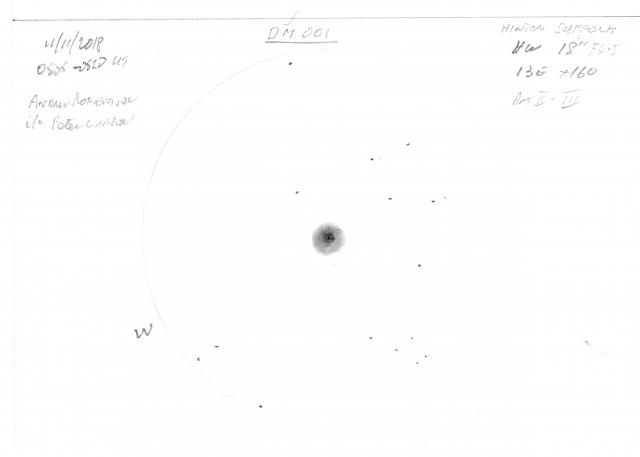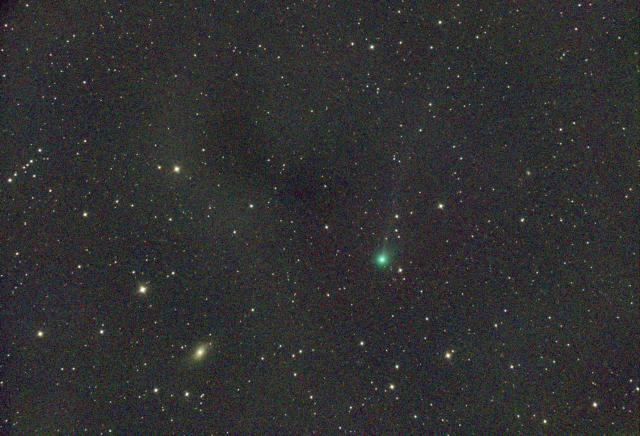- This topic has 25 replies, 10 voices, and was last updated 7 years, 1 month ago by
 David Swan.
David Swan.
-
AuthorPosts
-
8 November 2018 at 11:47 pm #574171
 Denis BuczynskiParticipant
Denis BuczynskiParticipantThis object is now designated as DM001 on the Posssible Comet Confimation Page of the Minor Planet Center
Róbert Fidrich Photometry of performed by Daniel Bamberger on my 60-60s CCD images made using T20 refractor with green filters at itelescope.net Mayhill, NM show 10.2 magnitude total brighness.
https://www.dropbox.com/s/flb6mbw4r33eer9/machholz.gif?dl=09 November 2018 at 1:22 pm #580203 Helen UsherParticipant
Helen UsherParticipantThis looks worth following up 🙂 I tried to get the ephemerides from JPL/MPC but inputting DM001 is not recognised. Any guidance on what/where to search for would be welcomed.
Thanks
Helen
9 November 2018 at 1:32 pm #580204 Denis BuczynskiParticipant
Denis BuczynskiParticipantHi Helen, here is a preliminary ephemeris by Nakano published on CBET 4569
Nakano provides the following preliminary ephemeris for the comet:
2018 TT R.A. (2000) Decl. Delta r
Nov. 5 12 06.22 -02 26.5 1.549 1.013
6 12 10.91 -02 21.2 1.549 1.012
7 12 15.60 -02 15.7 1.550 1.011
8 12 20.29 -02 10.2 1.550 1.011
9 12 24.97 -02 04.6 1.551 1.012
10 12 29.64 -01 59.0 1.552 1.012
11 12 34.30 -01 53.3 1.553 1.013
12 12 38.95 -01 47.6 1.555 1.014
13 12 43.59 -01 41.8 1.556 1.015
14 12 48.22 -01 36.0 1.558 1.017
15 12 52.84 -01 30.2 1.560 1.0199 November 2018 at 1:43 pm #580205 Helen UsherParticipant
Helen UsherParticipantThanks Denis 🙂 for both the data and the reference
I have time on the Faulkes Telescope and so was hoping to gather some useful data on this comet – no chance of doing it from home!
Helen
10 November 2018 at 9:39 am #580209 Nick JamesParticipant
Nick JamesParticipantI gave a talk to Newbury Astro Soc last Friday when I said that it was now very unlikely that we would get visual comet discoveries. How wrong I was! Congratulations to Don and the other independent discoverers of this comet.
An ephemeris based on all the available astrometry up to this morning is here. It was produced using Bill Gray’s FindOrb. These elements are still very uncertain but it looks like it is heading to a perihelion in early December. It is currently moving south and the elongation is decreasing so it will become increasingly difficult to observe. From the UK it is currently a morning object amongst the galaxies in Virgo. The column headed “/sig gives some idea of the position uncertainty (in arcsec).
Any observations (astrometry, photometry or images) would be gratefully received.
11 November 2018 at 7:15 am #580214 Nick JamesParticipant
Nick JamesParticipantDenis and I managed to image this comet this morning from Scotland. I’ve just posted a very quick process of one of the images here.
11 November 2018 at 8:32 am #580215 David SwanParticipant
David SwanParticipantVery nice. Hopefully I’ll be granted a half hour patch of clear skies in the morning some day soon. D
11 November 2018 at 9:43 am #580216 owen brazellParticipant
owen brazellParticipantI believe Peter Carson and Andrew Robertson saw this visually with an 18″ telescope from Suffolk this morning.proving that East Anglia does have the best weather 🙂 I am sure they will comment further.
Owen
11 November 2018 at 1:18 pm #580217 Nick JamesParticipant
Nick JamesParticipantOwen. Yes, Andrew Robertson and Peter Carson had a good view through Andrew’s 18-inch telescope at Haw Wood. They commented that the comet was bright and easy.
The latest ephemeris is here using all astrometry I have so far. I’ve done this starting 60 days before now and the positional uncertainties are now quite small. The comet has been at a small elongation for all of this time and was discovered when it was at its largest elongation. This is now decreasing. The comet has a small q (0.39 au) and is brightening rapidly.
Please try to observe this comet at any opportunity.
Nick.
11 November 2018 at 3:37 pm #580218 Grant PrivettParticipant
Grant PrivettParticipantWhat sort of brightness are we thinking?
Tuesday morning is looking clear here….
11 November 2018 at 4:38 pm #580219 Andrew RobertsonParticipant
Andrew RobertsonParticipantMy sketch from this morning attached. Location Haw Wood, Suffolk, 18″ F4.5 Dobsonian, 13mm Ethos e/p, x160.Thanks to Owen for alerting me (I had no e-mail) and Nick for the latest accurate co-ordinates.

Andrew
11 November 2018 at 4:56 pm #580220 Nick JamesParticipant
Nick JamesParticipantProbably 7.5 – 8.0 this morning. Any predictions will be very unreliable since it could be in the final stages of a bright outburst or not. Getting up early to observe it is the only way to find out!
11 November 2018 at 5:28 pm #580221 Nick JamesParticipant
Nick JamesParticipantOfficial designation is C/2018 V1.
12 November 2018 at 6:23 am #580223 David SwanParticipant
David SwanParticipantClear skies this morning – 12/11/2018 05:08. Still quite bright, with ion tail visible.
12 November 2018 at 6:34 am #580224 David SwanParticipant
David SwanParticipantFound this (!) frame in the set.
12 November 2018 at 6:57 am #580225 David SwanParticipant
David SwanParticipantDDP tends to bloat the stars and make them furry. Here’s a clearer image with the ion tail quite distinct. 12 x 10s, midpoint 05:14:30.
12 November 2018 at 7:12 am #580226 David SwanParticipant
David SwanParticipantAs Nick has said, the orbit is obviously very well determined. I updated MPCORB in Astrometrica, and the comet was spot on the predicted position.
12 November 2018 at 3:32 pm #580229 Nick JamesParticipant
Nick JamesParticipantDavid – Great image showing the tail. Denis and I managed to get some astrometry on it this morning but the conditions were poor so our images are rubbish.
13 November 2018 at 7:00 am #580232 Nick JamesParticipant
Nick JamesParticipantHere’s a quick process of a widefield image I took this morning with Denis Buczynski in northern Scotland. I’ll do a better job of processing this later and put the result on my members page. The galaxy is NGC4753.
 13 November 2018 at 7:09 am #580233
13 November 2018 at 7:09 am #580233 David SwanParticipant
David SwanParticipantAm I imagining things, or are there two tails in this image?
-
AuthorPosts
- You must be logged in to reply to this topic.
